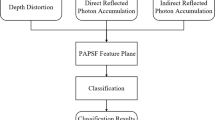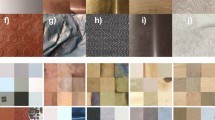Abstract
Highly transparent material classification can play an important role in the field of computer vision to classify glass or plastics for recycling and for home service robots to recognize transparent material. In these areas, there is a need to classify materials that are more than 73% transparent, but current transparent material classification methods cannot classify materials with full transparency levels. This paper proposes a highly transparent material classification method based on the refractive index, reflectivity, and transmissivity features from an imaging model of a time-of-flight (ToF) camera as the classification feature. First, we use the ToF camera to collect the depth and light intensity of the transparent material, as well as the scene information. The acquisition depth is distorted owing to the material characteristics of transparent materials. Second, we estimate the refractive index, reflectance, and transmittance from the depth distortion and IR (infrared rays) image. Finally, we choose a classifier that conforms to the nonlinear characteristics of the data to achieve transparent material classification. The method’s classification accuracy reached 94.1% in an experiment, indicating that our method considers the unique phenomenon of highly transparent materials reflecting against the background, incorporates this phenomenon into the ToF distance model, it can extract material features that express the characteristics of highly transparent materials, making it applicable to the classification of transparent materials at all levels of transparency.














Similar content being viewed by others
References
Lee, S., Shim, H.: Skewed stereo time-of-flight camera for translucent object imaging. Image Vis. Comput. 43, 27–38 (2015)
Brodbelt, R.H.W., O’brien, W.J., Fan, P.L.: Translucency of dental porcelains. J Dent Res 59(1), 70–75 (1980)
Kadambi, A., Whyte, R., Bhandari, A., Streeter, L., Barsi, C., Dorrington, A., Raskar, R.: Coded time of flight cameras: sparse deconvolution to address multipath interference and recover time profiles. ACM Trans. Graph 32(6), 10 (2013). https://doi.org/10.1145/2508363.2508428
Shim, H., Lee, S.: Recovering translucent objects using a single time-of-flight depth camera. IEEE Trans. Circuits Syst. Video Technol. 26(5), 841–854 (2015)
Tanaka, K., Mukaigawa, Y., Kubo, H., et al.: Recovering transparent shape from time-of-flight distortion. In: Proceedings of the IEEE Conference on Computer Vision and Pattern Recognition, pp. 4387–4395 (2016)
Ha, S., Lee, S.: Translucent surface detection by raycasting through multiple depth images. In: SIGGRAPH Asia 2018 Posters (SA '18), pp 1–2. Association for Computing Machinery, New York (2018)
Ohno, H.: Differential-geometry-based surface normal vector calculation method using a time-of-flight camera. Appl. Opt. 60, 5906–5911 (2021)
Huang, Y.Y., Sarkar, A., Schultz, P.C.: Relationship between composition, density and refractive index for Germania silica glasses. J Non-Crystal Solids 27(1), 29–37 (1978)
Born, M., Wolf, E.: Principles of optics, 7th edn. Cambridge University Press, Cambridge (2019)
Jerome, J., Workman, J.R.: Interpretive spectroscopy for near infrared. Appl. Spectrosc. Rev. 31(3), 251–320 (1996). https://doi.org/10.1080/05704929608000571
Acknowledgements
This work was supported by the Scientific Research Project of Beijing Educational Committee (No. KM 201910005027). The authors thank the anonymous referee for invaluable comments and suggestions.
Funding
This work was supported by the Scientific Research Project of Beijing Educational Committee (No. KM 201910005027).
Author information
Authors and Affiliations
Corresponding author
Ethics declarations
Ethical approval
This article does not contain any studies with human participants or animals performed by any of the authors.
Additional information
Publisher's Note
Springer Nature remains neutral with regard to jurisdictional claims in published maps and institutional affiliations.
Rights and permissions
Springer Nature or its licensor (e.g. a society or other partner) holds exclusive rights to this article under a publishing agreement with the author(s) or other rightsholder(s); author self-archiving of the accepted manuscript version of this article is solely governed by the terms of such publishing agreement and applicable law.
About this article
Cite this article
Lang, S., Chen, F. & Cai, Y. Highly transparent material classification using the refractive index, reflectivity, and transmissivity features from an imaging model of a time-of-flight camera. Machine Vision and Applications 34, 90 (2023). https://doi.org/10.1007/s00138-023-01443-w
Received:
Revised:
Accepted:
Published:
DOI: https://doi.org/10.1007/s00138-023-01443-w




